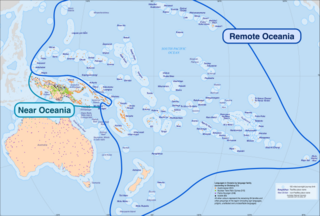Related Research Articles

Manus Island is part of Manus Province in northern Papua New Guinea and is the largest of the Admiralty Islands. It is the fifth-largest island in Papua New Guinea, with an area of 2,100 km2 (810 sq mi), measuring around 100 km × 30 km. Manus Island is covered in rugged jungles which can be broadly described as lowland tropical rain forest. The highest point on Manus Island is Mt. Dremsel, 718 metres (2,356 ft) above sea level at the centre of the south coast. Manus Island is volcanic in origin and probably broke through the ocean's surface in the late Miocene, 8 to 10 million years ago. The substrate of the island is either directly volcanic or from uplifted coral limestone.

The Bismarck Sea lies in the south-western Pacific Ocean within the Papua New Guinean exclusive economic zone. It is located north-east of the island of New Guinea and south of the Bismarck Archipelago. It has coastlines in districts of the Islands Region, Momase Region, and Papua Region.

Near Oceania is the part of Oceania that features greater biodiversity, due to the islands and atolls being closer to each other. The distinction of Near and Remote Oceania was first suggested by Pawley & Green (1973) and was further elaborated on in Green (1991). The distinction is based on geology, flora and fauna. Near Oceania was also settled by humans at an earlier time than Remote Oceania was. Near Oceania includes the island of New Guinea, Solomon Islands(excluding Temotu) and the Bismarck Archipelago. Sometimes Australia is also included in Near Oceania.

The approximately 450 Oceanic languages are a branch of the Austronesian languages. The area occupied by speakers of these languages includes Polynesia, as well as much of Melanesia and Micronesia. Though covering a vast area, Oceanic languages are spoken by only two million people. The largest individual Oceanic languages are Eastern Fijian with over 600,000 speakers, and Samoan with an estimated 400,000 speakers. The Gilbertese (Kiribati), Tongan, Tahitian, Māori and Tolai languages each have over 100,000 speakers. The common ancestor which is reconstructed for this group of languages is called Proto-Oceanic.

The Admiralty Islands languages are a group of some thirty Oceanic languages spoken on the Admiralty Islands. They may include Yapese, which has proven difficult to classify.
The Manus languages are a subgroup of about two dozen Oceanic languages located on Manus Island and nearby offshore islands in Manus Province of Papua New Guinea. The exact number of languages is difficult to determine because they form a dialect continuum. The name Manus originally designated an ethnic group whose members spoke closely related languages and whose coastal dwellers tended to build their houses on stilts out over the sea.

Baluan Island is the southernmost island of the Admiralty Islands group which makes up the majority of Manus Province in Papua New Guinea. It belongs to the Pam Islands, an island subgroup to the south of Lou Island. It is formed from an extinct volcano, also named Baluan.

The Western Islands are a group of islands in the Bismarck Archipelago, and within Manus Province of the Islands Region, in northern Papua New Guinea.

Bipi Island is a flat coral island located off the west coast of the main island of Manus in the Admiralty Group, Papua New Guinea. Adjacent and to the North East of Bipi Island is Sisi Island. Bipi Island consists of three villages, namely Masoh, Matahai, and Kum with approximately one thousand inhabitants.
The Kaniet languages were two of four Western Admiralty Islands languages, a subgroup of the Admiralty Islands languages, the other two being Wuvulu-Aua and Seimat. The languages were spoken on the Kaniet Islands in western Manus Province of Papua New Guinea until the 1950s.
The Bipi language is the westernmost West Manus language. It is spoken by approximately 1200 people on the Bipi and Sisi Islands off the west coast of Manus Island, Manus Province of Papua New Guinea. It has SVO word order.
The Nyindrou language is a West Manus language spoken by approximately 4200 people in the westernmost part of Manus Island, Manus Province of Papua New Guinea. It has SVO word order.
The Pam Islands are an island group of the Admiralty Islands archipelago in the Bismarck Sea, within Papua New Guinea.
Elu is an Austronesian language spoken on the northern coast of Manus Island, New Guinea. The usage of the language has been in decline in recent years.
Andra-Hus is an Austronesian language spoken on the islands of the same name, off the northern coast of Manus Island, New Guinea.
Loniu is an Austronesian language spoken along the southern coast of Los Negros Island in the Manus Province, immediately east of Manus Island in Manus Province, Papua New Guinea. Loniu is spoken in the villages of Loniu and Lolak, and there are estimated to be 450–500 native speakers, although some live in other Manus villages or on the mainland of Papua New Guinea.
Kurti is an Austronesian language spoken on the north coast of Manus Island in Papua New Guinea.
Ere is an Austronesian language spoken on the south coast of Manus Island in Papua New Guinea.
Keram Rural LLG is a local-level government (LLG) of East Sepik Province, Papua New Guinea.
Bisikani/Soparibeu Kabin Rural LLG is a local-level government (LLG) of Manus Province, Papua New Guinea.
References
- 1 2 Sori-Harengan at Ethnologue (18th ed., 2015) (subscription required)